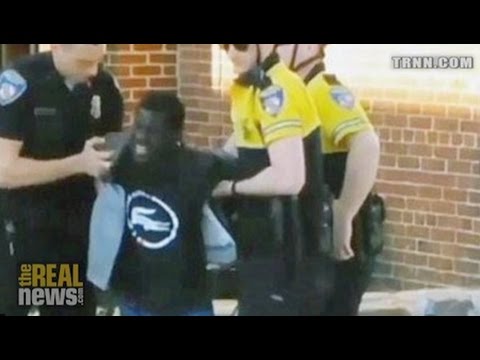
A. Dwight Pettit says the leaked police report stating Freddie Gray injured himself fits into a long pattern of police disinformation
Host: Jessica Devereaux
Studio: David Hebden, Adam Coley
Story Transcript
JESSICA DESVARIEUX, PRODUCER, TRNN: Welcome to The Real News Network. I’m Jessica Desvarieux in Baltimore. Today we have some big news developing out of Baltimore City Hall. Essentially the police are now saying that there is an unknown stop that the van had made, and before that we didn’t previously know that the van had made that stop. Also, the Washington Post is reporting that there was a second prisoner in the van who allegedly had told investigators that, quote, Gray was banging against walls inside the vehicle, and intentionally trying to injure himself. Here to unpack all of this is our in-studio guest A. Dwight Pettit. Dwight Pettit is a Baltimore civil rights lawyer who has represented many victims of police brutality. Thanks for joining us, Dwight. A. DWIGHT PETTIT, CIVIL RIGHTS ATTORNEY: Thanks for having me, Jessica. DESVARIEUX: So Dwight, you just heard me introduce some of this breaking news that’s coming out of Baltimore today. What is your response to all of this? PETTIT: Well as to the stop, that befuddles me because they should have been, have communications with the van. Why that’s new and surprise evidence is beyond me. That’s something that should be initial in the investigation of where, in the timeline, where it stopped, why it stopped and what have you. So this again adds to the mystery of what took place in the van and what took place outside of the van, and whether the injuries occurred in or out of the van, et cetera. But the second piece of evidence that you talked about in terms of this witness that was supposed to be in this truck. Now, I understand–first of all, from what I understand from the Post, he was in a–he wasn’t in the compartment with Mr. Gray. He was separated by some type of metal separation device. And so what you’re talking about, number one, is hearsay and conjecture because he’s saying that he believed he–from what I read or what I’ve heard, that he was doing something to inflict injury upon himself. You also have to understand, Jessica, that in the investigation process, Baltimore City police and those investigatory agencies are very hostile to witnesses. In many cases they’re intimidating to witnesses, or they threaten witnesses. They intimidate them, they question them very vigorously in very–in many cases, an intimidating environment. And we also don’t know anything about this person that was in the van, and yet to know whether or not he might be, have a criminal record, or whether he might be an informant. We don’t know anything as to what was offered to him. The discussions between him and the police. So we don’t know what he was subjected to or what have you. And knowing the Baltimore City Police Department and my 40 years of practicing law here and handling police excessive force cases, they basically control and get these witnesses who–really independent witnesses, they do a job on them, first of all. And something of this category where this has national attention and we don’t know about this person in the van, no telling what could come out that would attack the credibility of this witness. So I, I take this witness right now, regardless of the fact that it was in the Washington Post, I take it with a grain of salt. DESVARIEUX: And as you mentioned, you know this police force. You’ve been working directly with them, prosecuting–or attempting to prosecute–I’m sorry, not prosecute. But essentially you have clients that you are defending who have been victims of police brutality. PETTIT: And prosecution is the correct word in terms of civil litigation. Right. DESVARIEUX: Yes. In terms of civil litigation, yes. PETTIT: And like, you know, the West case, for example. Before I could get there, the police were either knocking door to door, asking who had a cell camera, intimidating–by the time I got there, the people that saw the beating of Mr. Tyrone West were scared to death. DESVARIEUX: Well let’s give our audience some of the facts of that Tyrone West case, because that’s a perfect example of some police brutality that has happened in the past here in Baltimore. PETTIT: A summer a year ago, I think it was, he was driving his vehicle, had a passenger in the car, up in Northeast Baltimore. Stopped by the so-called jump-out squad, where they have these–driving an unmarked car. Where these guys literally stopped him with no traffic violations and no articulable suspicion, no probable cause. He was put on the curb. While he was on the curb and they were doing something with him he decided to take off and run. No weapon or what have you. They catch him about 30 feet going up an embankment. And ten officers, ten Baltimore City police officers, beat him to death. Now, they admit–and we still got to take their depositions–but that he was stomped. He was kicked. He was Tasered. He was beat with batons and sticks, and he was beat by, with fists. And expired or passed out and died at the scene of the beating, while he was asking and screaming and hollering for them to stop. The odd part about this case is he had no prior medical history in terms of what the autopsy found, but the autopsy, the medical examiner comes back and says prior preexisting conditions. Well, I suggest to you that somebody that’s being beat by ten people–and possibly eleven, because there was a Morgan State police officer involved also. And somebody was sitting on his chest while this is going on. If you didn’t have a prior existing medical condition, you’re going to develop one while you’re taking this kind of beating. DESVARIEUX: Yeah. And in Gray’s case, we’re still waiting on the medical examiner to come out and determine what actually was the cause of death in the autopsy [inaud.] PETTIT: Well, they really never concluded–they never concluded homicide, I think it was undetermined. And that’s why we’re in the middle of this litigation as we speak. We are in fact issuing subpoenas for the depositions of the medical staff in the examination, because it’s taken all this time just to get all of the medical information. Because some things were contracted out to other medical facilities. And how that works and all, we’re going to get in the deposition. DESVARIEUX: In the case of Gray then, do you have confidence, you have any faith that the medical examiner will provide some fair results? PETTIT: I don’t have much faith in the Medical Examiner’s Office. When they do these autopsies, people are not aware, the police department’s sitting right in the autopsy room. You have four, five, six, seven police officers sitting there right while the doctor’s doing this. And so many cases you have that pervasive intimidation again, even in the Medical Examiner’s Office. So I don’t have much confidence in them. What might make this different is the, is the national scrutiny that this case is under might compel them to make sure that their office, which is a state office, is above-board and open. DESVARIEUX: Okay. Let’s talk–. PETTIT: Many cases, though–just to cut you [off]–we have to usually bring in our own medical people. Our own pathologist to back-check the medical examiners of the state of Maryland. DESVARIEUX: So that just shows the level of distrust there is between the medical examiner’s–. PETTIT: That’s almost automatic in a death case, is the way my office operates. DESVARIEUX: Understood. Understood. Okay, let’s switch gears a little bit and talk about the State Attorney’s Office. Now that they have the report from the police department, they–what are some of the challenges that the prosecutors are going to potentially face to even–even if they do indict, what is the likelihood that they’ll be able to convict the officers? PETTIT: Well, they’ve got to go through a broad spectrum in terms of what the evidence is going to show. Ms. Mosby I believe is going to look at that in a timely and reasonable manner. And of course we need the autopsy, see if they conclude whether a blow could have caused this injury or whether a fall, or what have you. So that’s an integral part of it, and I’m not sure that they had that. But she’s going to have to examine them and all the witnesses. And then she’s going to have to lay out the different elements of, levels of prosecution of whether she’s looking at first degree murder, whether she’s looking at second degree murder, whether she’s looking at reckless conduct, whether she’s looking at negligent homicide. So she’s got a whole level of items to look in terms of the level of what she believes she–if she believes that she can get an indictment. And because she’s, you know, as you’ve heard before, anybody can get an indictment. They can go in and indict a–you’ve heard this expression, a ham sandwich. So they can do that. So that’s not the point. But the credibility of her office is to be able to get an indictment, and for that indictment to be supported with enough facts and enough evidence that she can proceed in a logical, real way in terms of trial and getting a conviction. So she’s got to look at first degree murder, whether or not there is intent and premeditation, malice of forethought. Then she’s got to look at second degree murder, whether the killing and how that results. She’s got to look at the negligence of them not rendering medical assistance, or calling for medical assistance, whether that creates a negligent or manslaughter situation. And so she has put all these elements of these various crime–or these various possible charges–together with the facts, and she’s going to have to make decisions whether there’s anything there, whether there’s enough there, to in fact bring a criminal indictment. Because she doesn’t want to get stressed out just because of public opinion and bring an indictment that a good defense attorney comes in and knocks out before he can get to trial. So she wants something that’s going to show her integrity, and that’s the important word. The integrity of her office to render a fair and reasonable determination, whether it’s indictment or no indictment. DESVARIEUX: Well, we’ll certainly keep track of what the office is doing. And Dwight, we love to have you back in the studio to give us your point of view. Thank you so much for joining us. PETTIT: Thanks for having me. DESVARIEUX: And thank you for joining us on The Real News Network.
End
DISCLAIMER: Please note that transcripts for The Real News Network are typed from a recording of the program. TRNN cannot guarantee their complete accuracy.



